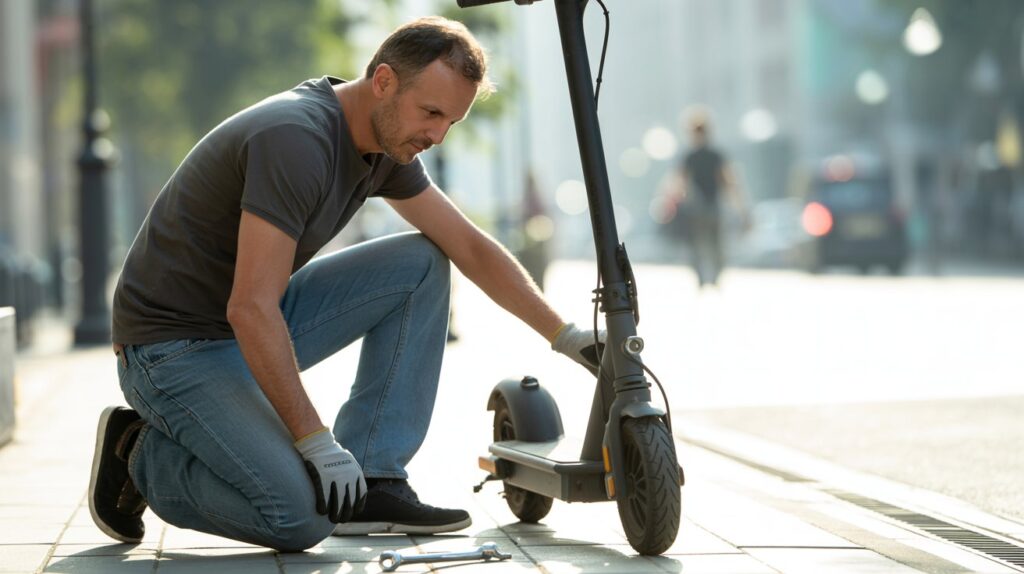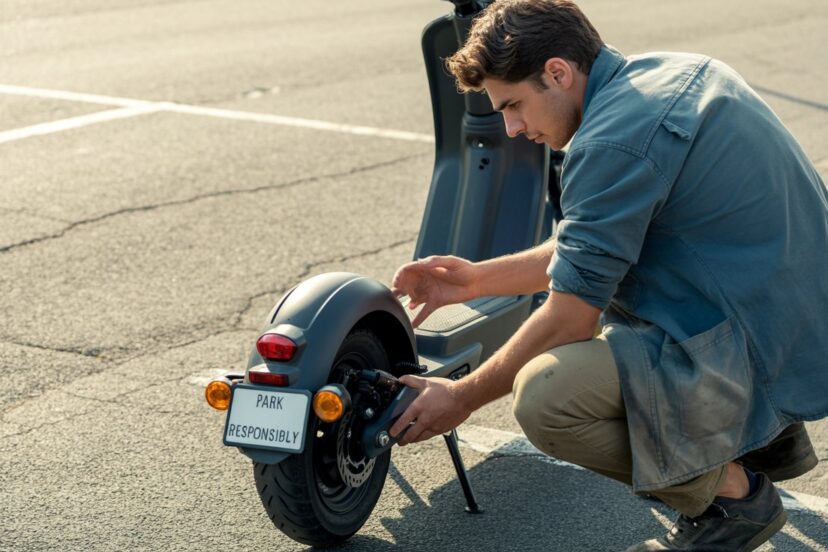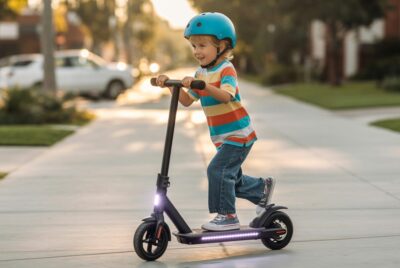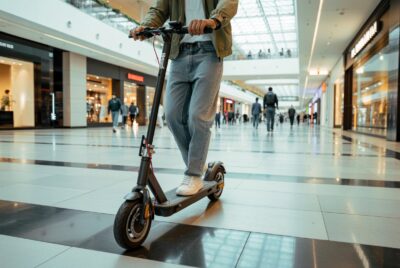E-Scooter Tires: Solid vs Air-Filled
*We may earn a commission for purchases made using our links. Please see our disclosure to learn more.
The rumble of wheels hitting pavement, the gentle hum of an electric motor, and the wind rushing past your face – these are the moments that define the modern urban commuting experience. Yet beneath this symphony of movement lies a critical decision that can make or break your daily rides: the choice between solid and air-filled e-scooter tires.
This fundamental component choice affects everything from your morning commute comfort to your weekend adventure capabilities. Whether you’re navigating bustling city streets filled with debris or cruising through smooth suburban paths, your tire selection will determine how smoothly, safely, and efficiently you travel.
“The right tire choice can transform your daily commute from a necessary chore into an eagerly anticipated part of your day, while the wrong choice can turn every ride into an exercise in frustration and discomfort.”
– Urban Mobility Research Institute
Key Takeaways
- Solid tires offer puncture-proof reliability and zero maintenance but sacrifice ride comfort and traction
- Air-filled tires provide superior comfort and grip but require regular maintenance and are vulnerable to punctures
- Terrain considerations play a crucial role in determining the best tire type for your specific riding conditions
- Cost implications extend beyond initial purchase to include maintenance, replacement, and potential downtime
- Performance trade-offs exist between durability and comfort, requiring careful consideration of your priorities
Understanding E-Scooter Tire Technologies
The evolution of e-scooter tire technology represents a fascinating intersection of engineering innovation and practical urban mobility needs. Traditional bicycles and motorcycles have long established the benefits of air-filled tires, but the unique demands of electric scooters have sparked renewed interest in solid tire alternatives.
Air-filled tires, also known as pneumatic tires, operate on a simple yet effective principle: compressed air provides cushioning between the wheel rim and the road surface. This air chamber acts as a natural shock absorber, distributing impact forces across the tire’s contact patch while maintaining optimal ground contact for traction and control.
Solid tires, conversely, eliminate the air chamber entirely, relying instead on dense rubber compounds or foam materials to provide structure and limited cushioning. These tires represent a return to the earliest days of wheeled transportation, updated with modern materials and manufacturing techniques to meet contemporary performance demands.
The Solid Tire Advantage: Durability and Reliability
Puncture-Proof Performance
The most compelling argument for solid tires lies in their complete immunity to punctures. Urban environments present countless hazards that can instantly deflate pneumatic tires: broken glass scattered across bike lanes, construction debris, thorns from roadside vegetation, and countless other sharp objects waiting to end a ride prematurely.
Solid tires transform these potential disasters into minor inconveniences. Riders can confidently navigate through areas where pneumatic tire users must exercise extreme caution or seek alternative routes. This reliability proves particularly valuable for commuters who depend on their e-scooters for daily transportation and cannot afford unexpected delays or costly repairs.
Maintenance-Free Operation
The elimination of air pressure monitoring represents another significant advantage of solid tire technology. Pneumatic tires require regular pressure checks and adjustments to maintain optimal performance and prevent premature wear. Underinflated tires increase rolling resistance, reduce battery range, and accelerate sidewall degradation, while overinflated tires compromise comfort and traction.
Solid tires completely eliminate these concerns. Once installed, they require no ongoing maintenance beyond occasional cleaning and visual inspection for excessive wear. This characteristic appeals particularly to casual riders who prefer a “set it and forget it” approach to their e-scooter ownership experience.
Long-Term Durability
Quality solid tires often outlast their pneumatic counterparts significantly. While air-filled tires may require replacement every 1,000 to 3,000 miles depending on usage patterns and maintenance quality, solid tires frequently exceed 5,000 miles before showing significant wear indicators.
This durability stems from their uniform construction and resistance to pressure-related failures. Pneumatic tires can fail suddenly due to sidewall weakening, valve stem deterioration, or catastrophic punctures, while solid tires typically exhibit gradual, predictable wear patterns that allow for planned replacement scheduling.
The Air-Filled Tire Experience: Comfort and Performance
Superior Ride Comfort
The comfort advantage of air-filled tires becomes immediately apparent when transitioning from solid alternatives. The pressurized air chamber provides genuine suspension effects, absorbing road imperfections and reducing the harsh impacts that solid tires transmit directly to the rider.
This comfort difference proves most pronounced on rough surfaces, where solid tires can create an almost jarring riding experience. Cobblestone streets, cracked pavement, and uneven surfaces that might discourage solid tire users become manageable and even enjoyable with properly inflated pneumatic tires.
The suspension effect extends beyond mere comfort to practical performance benefits. Better shock absorption reduces rider fatigue during longer journeys and minimizes the stress transmitted to the e-scooter’s frame and components, potentially extending overall vehicle lifespan.
Enhanced Traction and Control
Air-filled tires provide superior grip characteristics across various surface conditions. The tire’s ability to deform slightly under load increases the contact patch size, distributing weight more evenly and improving traction for acceleration, braking, and cornering maneuvers.
This traction advantage proves particularly valuable in challenging conditions such as wet surfaces, slight inclines, or loose debris. The tire’s flexibility allows it to conform to surface irregularities and maintain contact where rigid solid tires might lose grip and slip.
The improved control translates directly to safety benefits, particularly during emergency braking situations or when navigating unexpected obstacles. The enhanced grip provides riders with greater confidence and more predictable handling characteristics.
Optimal Rolling Efficiency
Properly inflated pneumatic tires typically offer lower rolling resistance than solid alternatives, particularly at higher speeds. This efficiency advantage can extend battery range and reduce energy consumption, making air-filled tires an attractive option for longer commutes or recreational rides.
The rolling efficiency stems from the tire’s ability to deform and recover energy during rotation, rather than constantly compressing solid materials that convert kinetic energy into heat. This characteristic becomes increasingly important as e-scooter speeds and ranges continue to improve.
Addressing Common Challenges and Concerns
Solid Tire Limitations
The primary drawback of solid tires lies in their limited shock absorption capability. Riders accustomed to pneumatic tire comfort may find the transition jarring, particularly on rough surfaces or during longer rides. The increased vibration transmission can lead to rider fatigue and reduced enjoyment, especially for recreational users.
Traction limitations represent another significant consideration. Solid tires, particularly those made from harder rubber compounds, may struggle to maintain grip on wet surfaces or loose debris. This characteristic requires riders to adjust their riding style and exercise additional caution in challenging conditions.
Weight considerations also favor pneumatic alternatives. Solid tires typically weigh more than their air-filled counterparts, potentially affecting e-scooter acceleration, handling, and overall battery efficiency. While this difference may seem minimal, it can accumulate over longer rides or when frequently carrying the scooter.
Pneumatic Tire Vulnerabilities
The convenience of solid tires becomes most apparent when dealing with pneumatic tire maintenance requirements. Regular pressure monitoring, seasonal adjustments for temperature changes, and the constant risk of punctures create ongoing responsibilities that some riders prefer to avoid.
Puncture repairs, while typically manageable, can strand riders far from home or repair facilities. Even minor punctures may require immediate attention to prevent further damage, potentially disrupting planned activities or commutes. The availability of repair materials and basic mechanical skills becomes essential for pneumatic tire users.
Cost considerations extend beyond initial purchase prices. Quality pneumatic tires may require more frequent replacement, and the ongoing costs of maintenance supplies, repair patches, and potential emergency repairs can accumulate over time.
Environmental and Terrain Considerations
Urban Environment Challenges
City riding presents unique challenges that influence tire selection decisions. Dense urban areas typically feature more road debris, construction zones, and surface irregularities that favor the puncture resistance of solid tires. However, the same environments often include rough pavement, expansion joints, and other surface features that benefit from pneumatic tire cushioning.
The frequency of stop-and-go traffic in urban environments emphasizes the importance of reliable braking traction, potentially favoring air-filled tires. Conversely, the presence of bike lanes with accumulated debris and the risk of glass or metal fragments may tip the balance toward solid tire reliability.
Suburban and Recreational Riding
Cleaner suburban environments with well-maintained roads may reduce the puncture risks that favor solid tires while emphasizing the comfort and performance advantages of pneumatic alternatives. Longer recreational rides particularly benefit from the reduced fatigue and enhanced comfort that air-filled tires provide.
The availability of repair facilities and the luxury of time for maintenance activities may make pneumatic tire ownership more manageable in suburban settings. Riders with garage storage and basic tool access can more easily handle routine maintenance and minor repairs.
Weather and Seasonal Factors
Weather conditions significantly influence tire performance characteristics. Wet surfaces emphasize the traction advantages of pneumatic tires, while winter conditions may favor the predictable, maintenance-free operation of solid alternatives.
Temperature changes affect pneumatic tire pressure, requiring seasonal adjustments and more frequent monitoring during periods of significant temperature variation. Solid tires remain unaffected by these environmental changes, maintaining consistent performance regardless of weather conditions.
Making the Right Choice for Your Needs

Assessing Your Riding Patterns
The optimal tire choice depends heavily on individual riding patterns and priorities. Daily commuters who depend on their e-scooters for transportation may prioritize the reliability and low maintenance requirements of solid tires, accepting comfort compromises for dependable operation.
Recreational riders who use their e-scooters for enjoyment and exercise may prefer the superior comfort and performance characteristics of pneumatic tires, accepting maintenance responsibilities for enhanced riding experiences.
Distance and duration considerations also influence optimal tire selection. Short urban commutes may favor solid tire reliability, while longer recreational rides benefit from pneumatic tire comfort and efficiency.
Budget and Maintenance Considerations
The total cost of ownership extends beyond initial purchase prices to include maintenance requirements, replacement frequency, and potential repair costs. Solid tires typically offer lower ongoing costs despite potentially higher initial investments, while pneumatic tires may require more frequent replacement and ongoing maintenance expenses.
Consider your mechanical aptitude and available time for maintenance activities. Pneumatic tires require basic mechanical skills and regular attention, while solid tires demand minimal ongoing involvement once properly installed.
Performance Priorities
Identify your most important performance characteristics. Riders who prioritize comfort, traction, and efficiency may prefer pneumatic tires despite maintenance requirements. Those who value reliability, durability, and maintenance-free operation may find solid tires more appealing.
Safety considerations should also influence your decision. Consider your typical riding conditions and whether the traction advantages of pneumatic tires or the reliability of solid alternatives better serve your safety needs.
Installation and Transition Considerations
Professional vs DIY Installation
Tire replacement on e-scooters can range from straightforward to complex, depending on wheel design and tire type. Some models feature easily removable wheels that simplify tire changes, while others require more extensive disassembly and specialized tools.
Consider your mechanical skills and available tools when planning tire transitions. Professional installation ensures proper mounting and balancing but adds to overall costs. DIY installation requires research, proper tools, and careful attention to manufacturer specifications.
Break-In Periods and Adaptation
Both tire types may require adaptation periods for optimal performance. Solid tires may feel harsh initially but often become more comfortable as both rider and tire adapt. The tire material may soften slightly with use, while riders develop techniques for managing the firmer ride characteristics.
Pneumatic tires require proper inflation and may need pressure adjustments as new tires seat properly on rims. Initial rides should focus on pressure optimization and traction familiarization, particularly if transitioning from solid alternatives.
Long-Term Ownership Experience
Wear Patterns and Replacement Indicators
Understanding wear patterns helps optimize tire lifespan and replacement timing. Solid tires typically show gradual, uniform wear that allows for predictable replacement scheduling. Look for significant tread depth reduction, cracking, or chunk loss as replacement indicators.
Pneumatic tires may exhibit various wear patterns depending on inflation maintenance and riding style. Uneven wear often indicates maintenance issues or alignment problems, while uniform wear suggests proper care and usage patterns.
Storage and Seasonal Considerations
Long-term storage requirements differ between tire types. Pneumatic tires may lose pressure during extended storage periods and require pressure checks before resuming use. Temperature extremes can accelerate pressure changes and potentially damage inadequately maintained tires.
Solid tires require minimal storage preparation but should be protected from extreme temperatures and direct sunlight that can accelerate rubber degradation. Proper storage extends tire lifespan and maintains performance characteristics.
Future Developments and Innovations
Hybrid Technologies
Emerging tire technologies attempt to combine the best characteristics of both solid and pneumatic designs. Foam-filled tires provide puncture resistance while offering improved comfort compared to traditional solid designs. Airless designs using advanced materials and engineering promise to eliminate puncture risks while maintaining ride quality.
These hybrid approaches may eventually eliminate the traditional trade-offs between solid and pneumatic designs, offering riders the reliability of solid tires with the comfort and performance of air-filled alternatives.
Smart Tire Technologies
Advanced tire monitoring systems and smart materials may enhance both solid and pneumatic tire performance. Embedded sensors could provide real-time feedback on tire condition, while advanced rubber compounds may offer improved durability and performance characteristics.
These developments promise to reduce the maintenance burden of pneumatic tires while potentially improving the comfort and performance characteristics of solid alternatives.
Conclusion
The choice between solid and air-filled e-scooter tires represents a fundamental decision that affects every aspect of your riding experience. Solid tires offer unmatched reliability and maintenance-free operation, making them ideal for urban commuters who prioritize dependability and minimal upkeep. Air-filled tires provide superior comfort and performance, appealing to riders who value ride quality and are willing to accept maintenance responsibilities.
Your optimal choice depends on a careful evaluation of your riding patterns, maintenance preferences, performance priorities, and budget considerations. Urban commuters navigating debris-filled streets may find solid tires’ puncture resistance invaluable, while recreational riders on cleaner paths may prefer the comfort and efficiency of pneumatic alternatives.
Rather than viewing this as a permanent decision, consider your tire choice as an evolving aspect of your e-scooter ownership experience. Your needs may change over time, and tire technology continues advancing to offer improved options for both reliability and performance.
The most important factor is making an informed decision based on your specific circumstances and priorities. Whether you choose the dependable simplicity of solid tires or the refined performance of air-filled alternatives, proper selection and maintenance will ensure many miles of safe, enjoyable riding.
Frequently Asked Questions
1. How long do solid tires typically last compared to air-filled tires?
Solid tires generally last 5,000+ miles with proper care, significantly longer than air-filled tires which typically need replacement every 1,000-3,000 miles. The durability advantage of solid tires stems from their resistance to punctures and pressure-related failures, though actual lifespan depends on riding conditions, weight load, and tire quality.
2. Can I switch from air-filled to solid tires on my existing e-scooter?
Most e-scooters can accommodate both tire types, but compatibility depends on your specific wheel design and size requirements. Check your scooter’s manual or consult with a dealer to ensure proper fitment. Some wheels may require professional installation, while others allow for straightforward DIY replacement.
3. Do solid tires really provide no shock absorption at all?
While solid tires provide significantly less shock absorption than air-filled alternatives, they do offer some cushioning through rubber compound flexibility and tread design. Higher-quality solid tires use softer compounds and specialized construction to improve comfort, though they still cannot match the natural suspension effect of compressed air.
4. How often should I check the pressure in air-filled e-scooter tires?
Check tire pressure weekly or before longer rides, as small tires lose pressure more quickly than larger vehicle tires. Temperature changes, normal permeation, and minor leaks can affect pressure significantly. Maintaining proper pressure optimizes comfort, traction, battery range, and tire lifespan.
5. Are there any safety differences between solid and air-filled tires in wet conditions?
Air-filled tires generally provide better wet weather traction due to their ability to conform to surface irregularities and maintain larger contact patches. Solid tires, particularly those with harder compounds, may be more prone to slipping on wet surfaces. However, proper riding technique and appropriate tread patterns can help mitigate these differences for both tire types.




